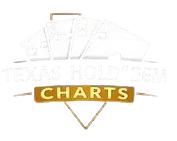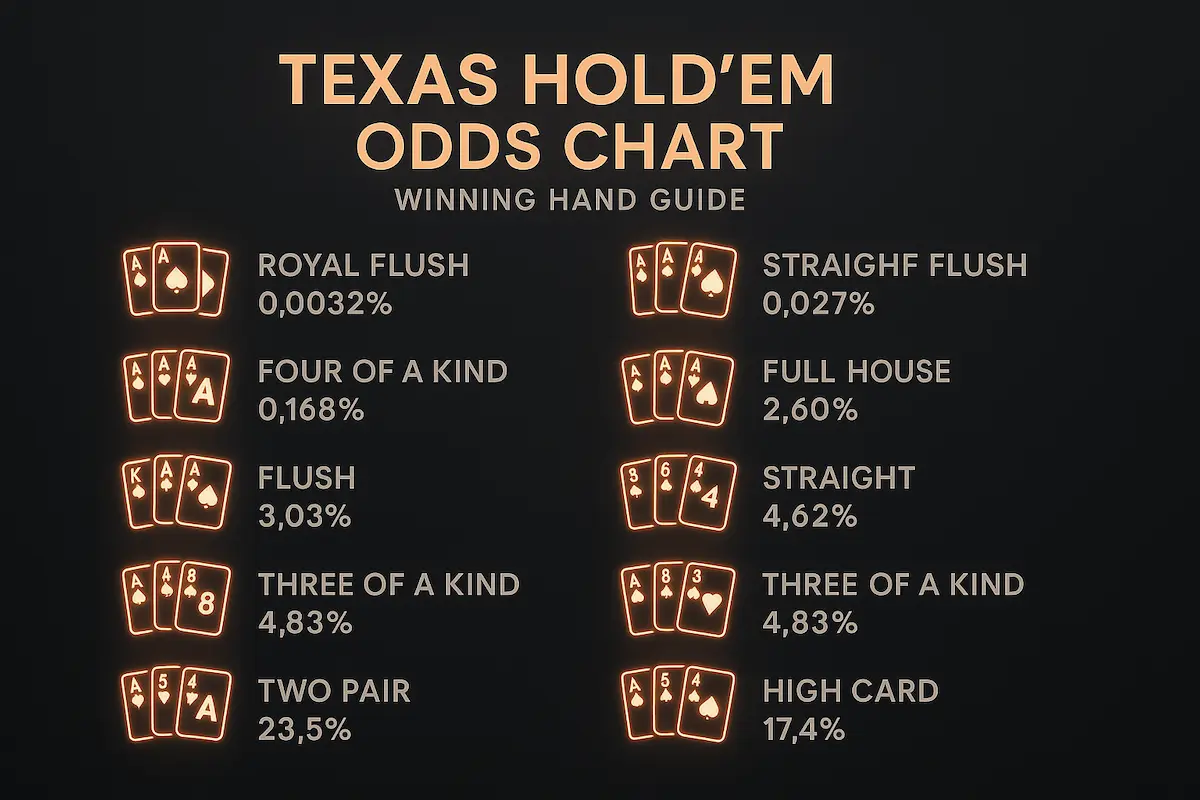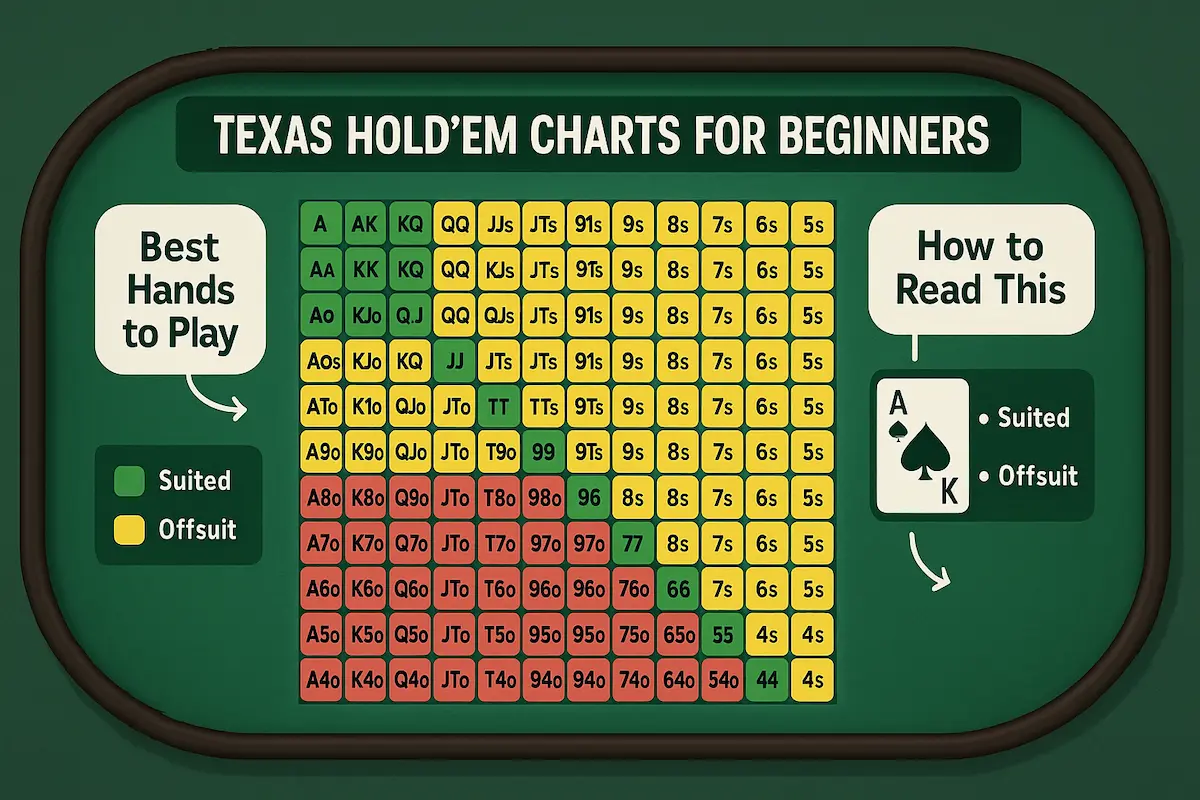Texas Hold’em poker is a strategic and mathematical game, where understanding your odds can mean the difference between a winning and losing session. For players serious about improving their game, two resources stand out: the Texas Hold’em odds chart and the Texas Hold ’em chart hands. Together, they form a foundation for making smarter decisions at the table.
In this guide, we’ll walk you through how to read and use these charts effectively, whether you’re a beginner building your skills or an advanced player refining your edge.
What Is a Texas Hold’em Chart?
A Texas Hold’em chart is a visual or tabular tool showing you how to evaluate your hand strength, pre-flop actions, and probabilities. There are several types of charts used in poker, and the two most popular are:
-
Chart of Starting Hands
-
Odds Chart for Post-Flop Play
These tools allow players to assess the value of their hands and make mathematically sound decisions, especially under pressure.
Looking for downloadable charts? Visit PokerStrategy.com and Upswing Poker for printable guides.
Texas Holdem Chart Hands: Understanding Starting Hand Charts
A Texas Holdem chart of hands categorizes all 169 unique pre-flop combinations in a 13×13 grid. These hands include:
-
Pocket Pairs (e.g., AA, 88)
-
Suited Hands (e.g., A♥K♥, Q♦J♦)
-
Off-suit Hands (e.g., K♠J♣)
The grid is often color-coded to help players quickly determine which hands to raise, call, or fold depending on position at the table.
Sample Chart Breakdown:
| Hand Type | Action | Example |
|---|---|---|
| Premium Hands | Raise any position | AA, KK, AKs |
| Strong Hands | Raise/call in most positions | QQ, JJ, AQs |
| Medium Hands | Raise in late position | KQ, AJ, 99 |
| Weak Hands | Fold unless in blinds | J9o, 55, Q8s |
These Texas Holdem chart hands are most useful in pre-flop decision-making and can dramatically reduce poor hand selections.
Position-Based Use of Chart Hands
Position plays a critical role in Hold’em strategy. The later your position, the wider your playable hand range should be. Most starting hand charts include columns for:
-
Early Position (UTG, UTG+1)
-
Middle Position (MP)
-
Late Position (CO, BTN)
-
Blinds (SB, BB)
Example:
-
In early position, play only AA–JJ, AKs, AQs.
-
In late position, add more speculative hands like 76s, QTs, and small pocket pairs.
Check out BlackRain79’s hand guide for a full list of starting hands by position.
What Is a Texas Hold’em Odds Chart?
A Texas Hold’em odds chart provides probabilities for various outcomes during a hand, like hitting a flush, improving a pair, or winning with a certain hand vs. another.
These charts are essential in:
-
Post-flop calculations
-
All-in situations
-
Draw analysis (flush, straight, etc.)
Why Use an Odds Chart?
Odds charts allow you to:
-
Estimate your chances of winning a hand
-
Make correct calls or folds based on pot odds
-
Identify profitable vs. unprofitable bluffs
Odds charts complement chart hands by giving you data to support in-game choices after the flop, turn, and river.
Common Texas Hold’em Odds Chart Scenarios
Here are some of the most valuable odds from standard Texas Hold’em charts:
1. Odds of Hitting a Pair on the Flop
-
Starting hand: two unpaired cards
-
Odds: ~32% (roughly 1 in 3)
2. Odds of Completing a Flush
-
Flush draw (4 suited cards) on the flop
-
Odds to hit flush on turn or river: ~35%
3. Odds of Hitting a Straight
-
Open-ended straight draw (e.g., 6-7-8-9)
-
Odds to hit by river: ~31.5%
4. Set Mining Odds
-
Start with a pocket pair, hit a set on the flop
-
Odds: ~11.8% (about 1 in 8.5)
Pot Odds vs. Hand Odds
To apply odds charts in real hands, you must understand pot odds—the ratio between the current pot size and the cost of a call.
Example:
-
Pot: $100
-
Opponent bets: $50
-
You need to call $50 to win $150 → Pot odds = 3:1
Compare this to your hand odds. If your draw completes 1 in 4 times (25%), then 3:1 pot odds make it a break-even call.
Learn how to calculate pot odds from PokerNews.
Using Odds Charts with Drawing Hands
Odds charts shine in situations where you’re chasing a draw.
Example: You hold A♦J♦, and the flop comes 2♦ 6♦ Q♣. You have a flush draw.
Odds of hitting a diamond:
-
On the turn: 9 outs / 47 unseen cards ≈ 19.1%
-
On the river (if missed turn): 9 outs / 46 ≈ 19.6%
-
Combined turn + river chance ≈ 35%
If your opponent bets the right amount, you can use this data to decide whether to call, raise, or fold based on pot odds.
Pre-Flop Hand vs. Hand Odds (Heads-Up)
Use Texas Hold’em odds charts to compare specific hand matchups:
| Your Hand | Opponent Hand | Win % |
|---|---|---|
| AA | KK | 81% |
| AKs | QJs | 63% |
| 77 | AKo | 54% |
| KQ | KJ | 75% |
| AQ | 22 | 47% |
Use PokerStove or Equilab to simulate real hand ranges.
Printable Texas Hold’em Odds and Hand Charts
Looking to download or print cheat sheets for home games or online grinding? Here are trusted resources:
You can tape these charts next to your screen or print them for live play until they become second nature.
Tips for Using Charts Effectively
-
Study in low-pressure environments (like free games or home games)
-
Review hands post-game using charts
-
Customize your charts as you develop your style
-
Combine odds with player reads — charts don’t replace psychology
-
Don’t over-rely: real poker involves adjusting to live table conditions
Conclusion: Combining Chart Hands and Odds for Poker Mastery
If you’re serious about improving your Texas Hold’em game, combining Texas Hold’em chart hands with a detailed odds chart gives you a powerful, data-driven approach. These tools reduce mistakes, improve consistency, and help you develop a profitable strategy for both cash games and tournaments.
Key Takeaways:
-
Use hand charts to know what to play pre-flop
-
Use odds charts to decide post-flop actions
-
Always compare pot odds to drawing odds
-
Update your chart usage based on table dynamics
Poker may be part luck—but long-term success belongs to those who understand math, probabilities, and disciplined strategy.



